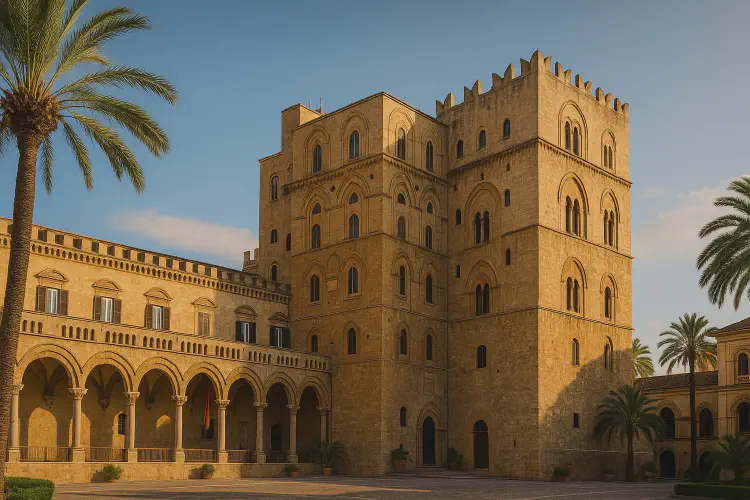Norman castles and cathedrals
The **Normans**, originally Viking descendants who settled in northern France, arrived in Sicily in the 11th century and transformed the island into a prosperous medieval kingdom. Their legacy lives on through grand **castles and cathedrals**, which still dominate the Sicilian landscape as symbols of strength, faith, and artistry.
- Visit Sicily
- 3 min read

Norman Castles and Cathedrals — Sicily’s Medieval Majesty
🛡️ Historical Background
After conquering Sicily from the Arabs in the 1060s, the Normans established the Kingdom of Sicily (1130–1194) under Roger II. They brought stability, administrative order, and a unique architectural style blending Romanesque, Arab, and Byzantine influences. Their castles and cathedrals reflected both military power and spiritual devotion, creating some of the island’s most iconic landmarks.
🏰 Famous Norman Castles in Sicily
1. Palazzo dei Normanni (Norman Palace), Palermo
Originally an Arab fortress, later transformed by the Normans into a royal residence. Today it houses the Sicilian Regional Assembly and the magnificent Palatine Chapel (Cappella Palatina) — a masterpiece of Arab-Norman art with golden mosaics and a muqarnas ceiling.
2. Castello di Caccamo
Perched dramatically on a hill near Palermo, this is one of Sicily’s best-preserved medieval castles. Built in the 12th century, it features fortified towers, dungeons, and panoramic terraces overlooking the surrounding valley and lake.
3. Castello di Lombardia, Enna
Standing 970 meters above sea level, this massive fortress was once one of the largest in southern Italy. It was expanded under the Normans and served as a strategic stronghold in the island’s center. Its towers offer breathtaking views over Sicily’s interior.
4. Castello di Venere, Erice
Built on the ruins of an ancient temple dedicated to Venus, this castle combines myth and medieval might. The Normans reinforced it for defense while preserving its sacred aura. From its ramparts, visitors can see Trapani, the Egadi Islands, and even Tunisia on clear days.
5. Castello di Milazzo
Overlooking the Tyrrhenian Sea, this fortress evolved through Arab, Norman, and later Spanish phases. The Norman section includes walls and a keep typical of their fortification style.
6. Castello Ursino, Catania
Commissioned by Emperor Frederick II (heir of the Norman dynasty) in the 13th century, this castle once stood on the coast but is now inland due to lava flows from Mount Etna. It now serves as Catania’s civic museum.
⛪ Norman Cathedrals in Sicily
1. Monreale Cathedral
A crown jewel of Norman architecture, built by William II in the late 12th century.
- Features 6,000 square meters of gold mosaics depicting biblical scenes.
- The cloister combines Arab arches and Romanesque sculpture.
- Symbolizes the cultural harmony of Norman Sicily.
2. Cefalù Cathedral
Commissioned by Roger II as part of his vow to God after surviving a storm.
- Features twin Norman towers and a Byzantine-style interior.
- The Christ Pantocrator mosaic in the apse is one of Sicily’s most celebrated religious artworks.
3. Palermo Cathedral
Originally built on the site of a mosque, it evolved through centuries of Arab, Norman, and Gothic influence.
- Houses royal tombs, including that of Roger II.
- Its exterior blends crenellations, domes, and intricate stone carvings, reflecting Sicily’s multicultural identity.
🕍 Architectural Features
Norman architecture in Sicily stands out for its fusion of northern European strength with Mediterranean grace:
- Massive stone walls and towers for defense.
- Pointed arches and domes inspired by Islamic architecture.
- Byzantine mosaics illuminating interiors with gold and color.
- Decorative carvings featuring flora, animals, and geometric motifs.
This combination created a style both monumental and elegant, deeply symbolic of Sicily’s diversity.
🧭 Summary
The Norman castles and cathedrals of Sicily are not just architectural marvels — they are monuments to an era of cultural fusion and royal ambition. From the golden mosaics of Monreale to the mighty walls of Caccamo, they tell the story of a kingdom that once united Europe, Africa, and the East. Exploring them is to step back into a time when Sicily stood at the crossroads of power, faith, and beauty.